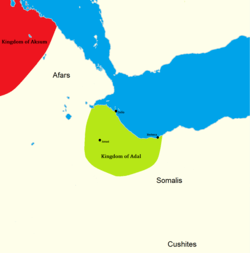Adal Kingdom
| Kingdom of Adal Boqortooyadii Adal | |||||||||
|---|---|---|---|---|---|---|---|---|---|
| 9th century–13th century | |||||||||
 Approximate extension of the Kingdom of Adal. | |||||||||
| Capital | Zeila | ||||||||
| Common languages | Somali · Arabic | ||||||||
| Religion |
Islam | ||||||||
| Government | Monarchy | ||||||||
| History | |||||||||
• Established | 9th century | ||||||||
• Decline | 13th century | ||||||||
| |||||||||
| Today part of |
| ||||||||
The kingdom of Adal was a Somali Muslim kingdom centered around Zeila. It was established by the local Somali tribes in the 9th century. Its capital and headquarters was Zeila, which attracted many merchants around the world, contributing to the wealth of the city. Zeila is an ancient city and it was one of the earliest cities in the world to embrace Islam.[1]
Origins and History
In the late 9th century, Al-Yaqubi was an Armenian Muslim scholar and traveller in the 9th century wrote that the Kingdom of Adal was a small wealthy Somali kingdom and that its capital, Zeila, served as the headquarters for the kingdom, which dates back to the 9th century.[2][3]
Adal kingdom, also known as the Kingdom of Adal, was mostly located in Somali territories from western Somaliland to Southern Djibouti and to eastern Ethiopia, Somali Region.
Most scholars claim that both the Adal kingdom and the Shewa Sultanate existed in the same time in the 10th century, and yet had nothing to do with each other. Adal kingdom was succeeded by the Ifat Sultanate, which was located mostly in northern Somali territories, while the Shewa Sultanate was located in central Ethiopia and had no connection with the northern Somali Sultanates. Historically, both the Ifat Sultanate and the Shewa Sultanate warred with each other over Islamic supremacy in the Horn of Africa. The conquest of Shewa by the Ifat Sultanate ignited a rivalry for supremacy between the Christian Solomonids and the Muslim Ifatites, which resulted in several devastating wars. After these wars, the reigning king had his minstrels compose a song praising his victory, which hailed the powerful "Somali" warriors that succeeded in every battle from the Somali ruler called Sa'ad ad-Din II.[4][5]
Yusuf bin Ahmad al-Kawneyn is believed to be born in Zeila during the Adal Kingdom period, with which he associated. Yusuf bin Ahmad al-Kawneyn is a very famous Somali saint.[6] He is believed to be the founder and ancestor of the royal family known as the Walashma Dynasty, which governed both the Ifat Sultanate and the Adal Sultanate during the Middle Ages.[7][8]
References
- ↑ https://image.prntscr.com/image/OhfIs5KhR-yhBdrzIq922w.png
- ↑ Encyclopedia Americana, Volume 25. Americana Corporation. 1965. p. 255.
- ↑ Lewis, I.M. (1955). Peoples of the Horn of Africa: Somali, Afar and Saho. International African Institute. p. 140.
- ↑ https://books.google.co.uk/books?id=Q0pZPp032c0C&pg=PA43&dq=medieval+Somali+history&hl=en&sa=X&ved=0ahUKEwjWlKHSzNXXAhWRJhoKHRrUCbsQ6AEIPzAE#v=onepage&q=medieval%20Somali%20history&f=false
- ↑ https://books.google.co.uk/books?id=kSYkCQAAQBAJ&pg=PA49&dq=Ifat+Sultanate+was+a+somali+kingdom&hl=en&sa=X&ved=0ahUKEwjsovD0htXYAhUOb1AKHX9hDuEQ6AEISTAG#v=onepage&q=Ifat%20Sultanate%20was%20a%20somali%20kingdom&f=false
- ↑ Lewis, I.M. (1998). "Saints and Somalis: Popular Islam in a Clan-based Society", The Red Sea Press, Retrieved on 22 September 2015.
- ↑ Lewis, I. M (1998). Saints and Somalis: Popular Islam in a Clan-based Society. The Red Sea Press. p. 89.
- ↑ Nehemia Levtzion; Randall Pouwels (Mar 31, 2000). The History of Islam in Africa. Ohio University Press. p. 242.
Aw Barkhadle, is the founder and ancestor of the Walashma dynasty